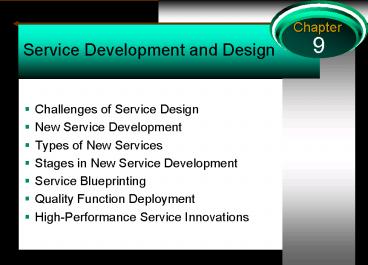Service Development and Design - PowerPoint PPT Presentation
1 / 15
Title:
Service Development and Design
Description:
... Service ... Screen ideas against new service strategy. Test concept with ... New Service Strategy Matrix for Identifying Growth Opportunities ... – PowerPoint PPT presentation
Number of Views:540
Avg rating:3.0/5.0
Title: Service Development and Design
1
Service Development and Design
Chapter
9
- Challenges of Service Design
- New Service Development
- Types of New Services
- Stages in New Service Development
- Service Blueprinting
- Quality Function Deployment
- High-Performance Service Innovations
2
Provider Gap 2
CUSTOMER
COMPANY
Customer-Driven Service Designs and Standards
Service Design and Standards Gap
Company Perceptions of Consumer Expectations
Part 4 Opener
3
Figure 9.1Risks of Relying on Words Alone to
Describe Services
- Oversimplification
- Incompleteness
- Subjectivity
- Biased Interpretation
4
Types of New Services
- major or radical innovations
- start-up businesses
- new services for the currently served market
- service line extensions
- service improvements
- style changes
5
Figure 9.2New Service Development Process
- Business strategy development or review
- New service strategy development
- Idea generation
Front-end Planning
Screen ideas against new service strategy
- Concept development and evaluation
Test concept with customers and employees
- Business analysis
Test for profitability and feasibility
- Service development and testing
Conduct service prototype test
- Market testing
Implementation
Test service and other marketing-mix elements
- Commercialization
Sources Booz-Allen Hamilton, 1982 Bowers,
1985 Cooper, 1993 Khurana Rosenthal 1997.
- Postintroduction evaluation
6
Figure 9.3New Service Strategy Matrix for
Identifying Growth Opportunities (p. 260)
Markets
Product Offerings
Current Customers
New Customers
- Market Development
- Geographic expnsn.
- Franchising
- Strategic alliance
- Share Building
- Penetration strategy
- Market niche
Existing Services
- Diversification
- Related
- Unrelated
- Service development
- Incremental
- Radical
New Services
7
Figure 9.5Service Blueprinting
- a picture or map that accurately portrays the
service system. - A tool for simultaneously depicting the service
process, the points of customer contact, the
roles of customers and employees, and the
evidence of service from the customers point of
view.
Process
Service Blueprint
Points of contact
Evidence
8
Figure 9.6Service Blueprint Components (p. 268)
The total customer experience area
Two areas of contact employee actions 1.
Actions performed that are visible to the
customer.
2. Backstage actions not seen by the customer.
Internal actions that support the contact
employees in delivering service.
9
Figure 9.7Blueprint for Express Mail Delivery
Service
Truck Packaging Forms Hand-held Computer Uniform
Truck Packaging Forms Hand-held Computer Uniform
PHYSICAL EVIDENCE
Customer Gives Package
CUSTOMER
Line of interaction
Driver Picks Up Package
(On Stage)
Deliver Package
CONTACT PERSON
Line of visibility
(Back Stage)
Customer Service Order
Line of internal interaction
Airport Receives Loads
Fly to Sort Center
Load On Truck
Dispatch Driver
Unload Sort
Fly to Destination
Load on Airplane
SUPPORT PROCESS
Sort Packages
10
Figure 9.8Blueprint for Overnight Hotel Stay
Service
Hotel Exterior Parking
Cart for Bags
Desk Registration Papers Lobby Key
Elevators Hallways Room
Cart for Bags
Room Amenities Bath
Menu
Delivery Tray Food Appearance
Food
Bill Desk Lobby Hotel Exterior Parking
PHYSICAL EVIDENCE
Arrive at Hotel
Give Bags to Bellperson
Call Room Service
Check out and Leave
Go to Room
Receive Bags
Sleep Shower
Receive Food
CUSTOMER
Eat
Check in
Line of Interaction
Greet and Take Bags
(On Stage)
Deliver Bags
Deliver Food
Process Registration
Process Check Out
CONTACT PERSON
Line of Visibility
Take Food Order
(Back Stage)
Take Bags to Room
Line of Internal Interaction
Prepare Food
Registration System
SUPPORT PROCESS
11
Reading Using Service Blueprints (p. 272)
- To understand
- the customers point of view read from left to
right. - contact employees roles read horizontally
focusing on the activities directly above below
the line of visibility. - the integration of the various elements of the
service process, analyze vertically. - service redesign, the blue print can be looked at
as a whole to assess the complexity of the
process. - Clearly, one of the greatest benefits of
blueprinting is education.
12
Figure 9.9Building a Service Blueprint (p. 273)
the final product is not necessarily the only
goal. Goals can include clarification of the
concept, development of a shared service vision,
recognition of complexities and intricacies of
the service that are not initially apparent, and
delineation of roles and responsibilities, to
name a few.
Step 6 Add evidence of service at each customer
action step
Step 4 Map contact employee actions, onstage and
back-stage, and/or technology actions
Step 5 Link contact activities to needed support
functions
Step 2 Identify the customer or customer segment
Step 3 Map the process from the customers point
of view
Step 1 Identify the process to be blue-printed
p. 275
p. 275
Why?
13
Application of Service Blueprints
- New Service Development
- concept development
- market testing
- Supporting a Zero Defects Culture
- managing reliability
- identifying empowerment issues
- Service Recovery Strategies
- identifying service problems
- conducting root cause analysis
- modifying processes
14
Blueprints Can Be Used By
- Human Resources Management
- empowering the human element
- job descriptions
- selection criteria
- appraisal systems
- System Technology
- providing necessary tools
- system specifications
- personal preference databases
- Service Marketers
- creating realistic customer expectations
- service system design
- promotion
- Operations Management
- rendering the service as promised
- managing fail points
- training systems
- quality control
15
Figure 9.10House of Service Quality for Village
Volvo
Source J. A. Fitzsimmons and M. J. Fitzsimmons,
Service Management, 3rd ed. (New York Irwin
McGraw-Hill, 2000), p. 58.































